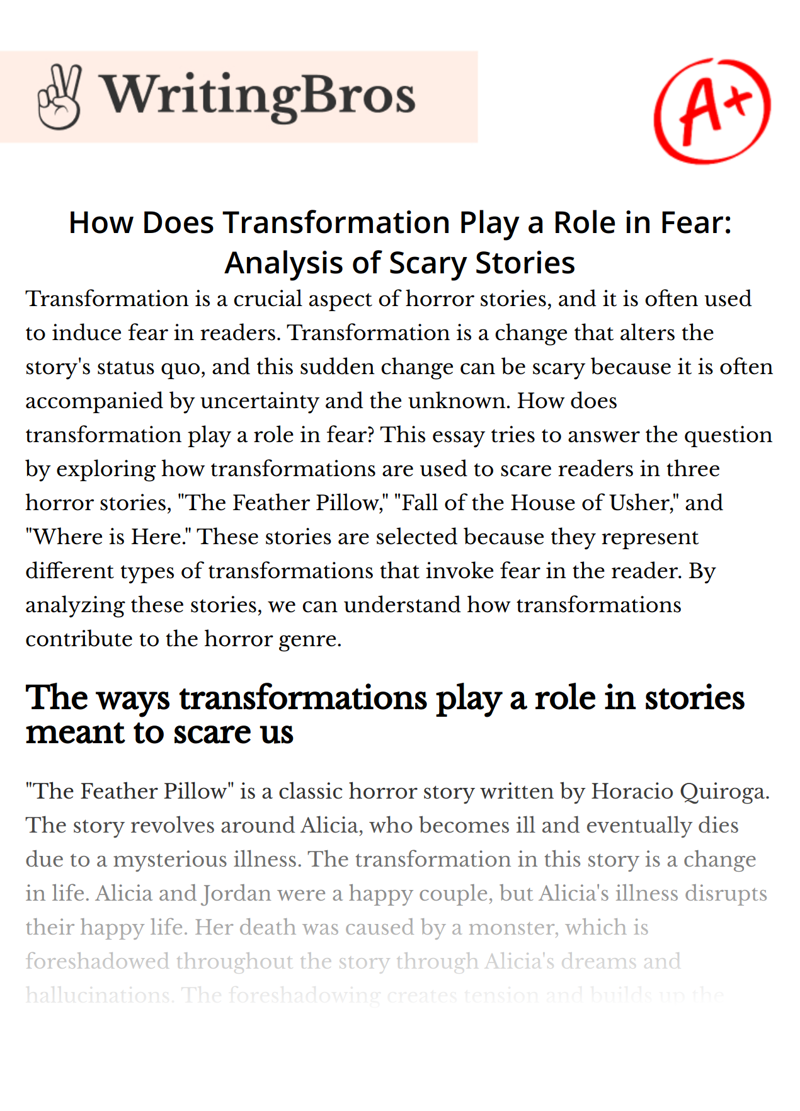How Does Transformation Play a Role in Fear: Analysis of Scary Stories

Transformation is a crucial aspect of horror stories, and it is often used to induce fear in readers. Transformation is a change that alters the story's status quo, and this sudden change can be scary because it is often accompanied by uncertainty and the unknown. How does transformation play a role in fear? This essay tries to answer the question by exploring how transformations are used to scare readers in three horror stories, "The Feather Pillow," "Fall of the House of Usher," and "Where is Here." These stories are selected because they represent different types of transformations that invoke fear in the reader. By analyzing these stories, we can understand how transformations contribute to the horror genre.
The ways transformations play a role in stories meant to scare us
"The Feather Pillow" is a classic horror story written by Horacio Quiroga. The story revolves around Alicia, who becomes ill and eventually dies due to a mysterious illness. The transformation in this story is a change in life. Alicia and Jordan were a happy couple, but Alicia's illness disrupts their happy life. Her death was caused by a monster, which is foreshadowed throughout the story through Alicia's dreams and hallucinations. The foreshadowing creates tension and builds up the mystery surrounding Alicia's illness, which in turn makes the story even scarier. The audience fears the absolute worst, and the story delivers on that fear when Alicia dies. The change in life is what makes the scary story scary, and this is what makes "The Feather Pillow" a classic horror story.
Next, in "Fall of the House of Usher," Edgar Allan Poe uses transformation to create horror. The story revolves around Roderick Usher and his sister, who both suffer from mental illnesses. The transformation in this story is a change in mental stability. Roderick's mental condition is connected with the house's wellness, and the narrator spends time with him, fearing that he might unravel. The tension builds as the narrator observes Roderick's behavior and mental stability throughout the story. Roderick's transformation for the worst creates fear in the audience, and when he dies, the narrator fears that the house will collapse. The story's ending leaves readers with a sense of dread, and this is what makes "Fall of the House of Usher" a classic horror story.
Finally, in "Where is Here," Joyce Carol Oates uses transformation to create a sense of horror. The story revolves around a family that lives in a house that seems to be alive. The transformation in this story is a physical change. The father starts noticing the house changing, and this seems unnatural and scary to him. The house's transformation is what makes the story seem scary because it is an unnatural occurrence. The father fears the unknown because houses do not transform within seconds by themselves. Additionally, the mother and father undergo a mental transformation, which creates tension and adds to the story's horror. The story's climax, where the stranger enters the house, creates a sense of terror in the reader, and this is what makes "Where is Here" a classic horror story.
In conclusion, transformations play a crucial role in horror stories. They create uncertainty, and this uncertainty creates tension, which is essential for a horror story to be effective. The three stories analyzed in this essay show how transformations can be used to invoke fear in readers. In "The Feather Pillow," Alicia's death creates a change in life that disrupts the story's status quo. In "Fall of the House of Usher," Roderick's transformation for the worst creates a sense of dread in the reader, and in "Where is Here," the physical transformation of the house creates a sense of horror. These transformations, along with the mental transformations in each of the stories, create a sense of fear
References
- Carroll, N. (1990). The philosophy of horror, or, paradoxes of the heart. Routledge.
- Halberstam, J. (1995). Skin shows: Gothic horror and the technology of monsters. Duke University Press.
- Shiraishi, S. (2013). The horror genre: The key to analyzing The Fall of the House of Usher. Japanese Journal of American Studies, (24), 37-51.
- Smith, A. M. (2019). Modern Gothic: A Reader. Bloomsbury Publishing.
- Sobchack, V. (1997). Screening space: The American science fiction film. Rutgers University Press.
- SparkNotes Editors. (n.d.). SparkNote on Poe’s Short Stories. Retrieved April 21, 2023, from https://www.sparknotes.com/short-stories/
Cite this Essay
To export a reference to this article please select a referencing style below

